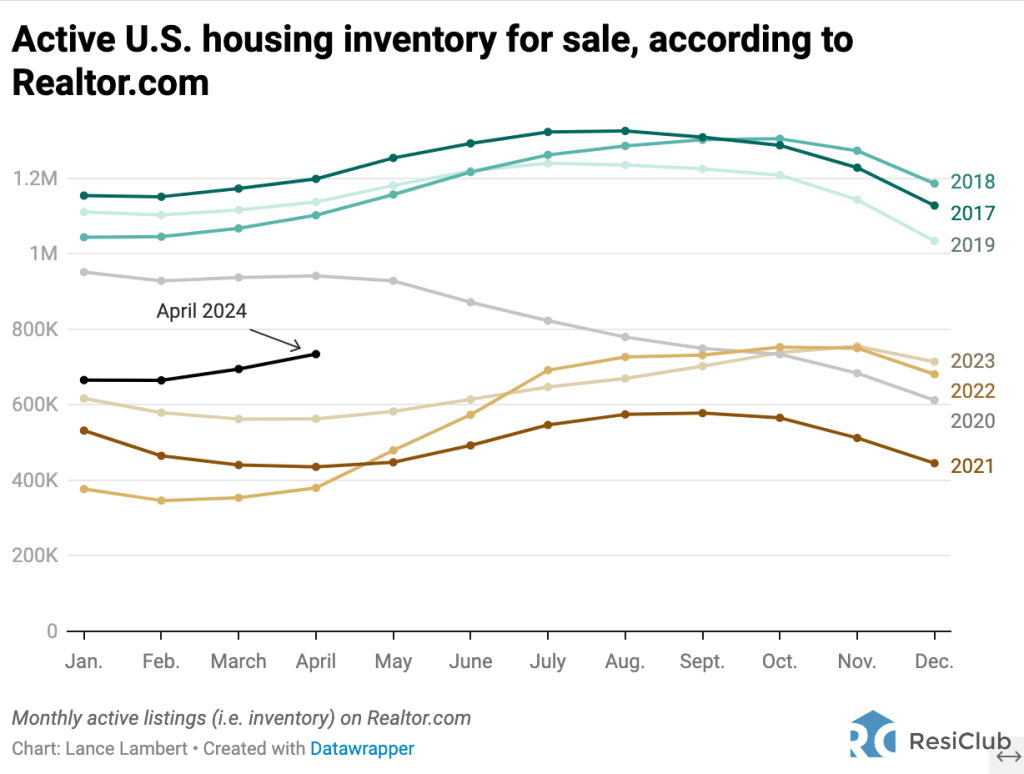Housing market inventory is shifting. Here’s what the data shows
Housing market inventory is shifting. Here’s what the data shows
The housing market saw a 30% increase in active inventory in April, but that’s still 35% below pre-pandemic levels.
Want more stories from Lance Lambert’s ResiClub in your inbox? Subscribe to the free, daily ResiClub newsletter.
When assessing home price momentum, it’s important to monitor active listings and months of supply. If active listings start to rapidly increase as homes remain on the market for longer periods, it may indicate potential future pricing weakness. Conversely, a rapid decline in active listings could suggest a market that is heating up.
Given the absence of an excessive amount of existing inventory on the market, it makes sense that spiked mortgage rates and strained affordability haven’t resulted in more regional home price corrections.
We are starting to see national active listings rise (up 30% between April 2023 and April 2024); however, housing market inventory is still well below pre-pandemic levels (35% below April 2019).*

Here’s what the total April inventory/active listings have looked like over the past eight years, according to Realtor.com:
April 2017: 1,198,424
April 2018: 1,102,064
April 2019: 1,137,198
April 2020: 941,733
April 2021: 435,663
April 2022: 379,978
April 2023: 562,966
April 2024: 734,318
Click here to view an interactive version of the map below.
On a regional level, the year-over-year state shift in housing market inventory varies a lot. For instance, in Nevada, active listings are down 12% on a year-over-year basis as markets like Reno and Las Vegas tightened up following a brief home price correction in the second half of 2022. Meanwhile, active listings are up 64% in Florida on a year-over-year basis.
The bulk of the Florida inventory increase is really concentrated in sections of Southwest Florida. In particular, in markets like Cape Coral and Fort Myers, which were hard-hit by Hurricane Ian in September 2022. Hurricane Ian left behind thousands of damaged homes, and the subsequent need for renovations has resulted in a surge in available inventory. According to the National Oceanic and Atmospheric Administration, Hurricane Ian caused an estimated $112.9 billion worth of total damage, making Ian the third-costliest U.S. hurricane on record.
In addition to residential property damage, the hurricane has also coincided with spiked home insurance costs. This combination of increased housing supply for sale—the damaged homes—coupled with strained demand—the result of spiked home prices, spiked mortgage rates, higher insurance premiums, and higher HOAs—has translated into market softening across much of Southwest Florida.
Click here to view an interactive version of the map below.
Still most of the country still remains below pre-pandemic levels of inventory/months of supply. Much of the Midwest and Northeast, in particular, remains very tight.
Big picture: We’re observing some softening in many housing markets as higher mortgage rates temper the fervor of a market that was unsustainably hot during the pandemic housing boom; however, home prices in most housing markets are still rising.
ABOUT THE AUTHOR
(15)



